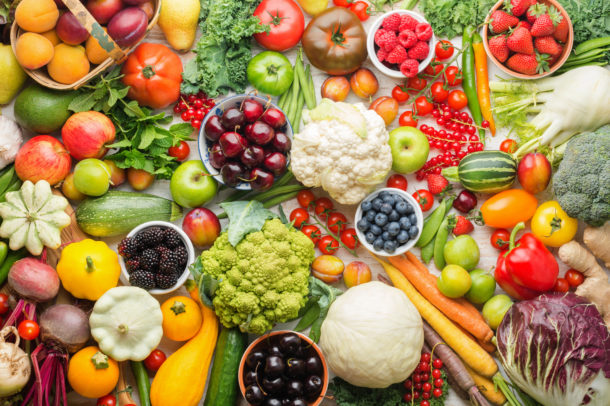By Julie Hutter, RD, CDE
This is the second blog article in our What’s in Season? Series. Look for the final feature in November for delicious ways to prepare the autumn harvest.
With summer well under way, so are farmers’ markets and fruit/vegetable stands. Enjoying in-season* produce has many benefits. At its freshest, it offers maximal flavour, provides important nutrients to support our health, and reduces our environmental footprint. Purchasing in-season produce also helps to support our local communities and farmers. Additionally, in-season produce tends to be less expensive than out-of-season varieties.
There are many low-potassium fruit and vegetables to enjoy in late summer. These include:
August
- Fruit: apples, apricots, blackberries, blueberries, cherries, cranberries, gooseberries, grapes, pears, plums, raspberries, Saskatoon berries, strawberries, and watermelon
- Vegetables: cabbage, carrots, cauliflower, corn, cucumber, eggplant, lettuce, peppers, snow/green peas, onions, radishes, summer squash and yellow/green beans
September
- Fruits: apples, blueberries, cranberries, grapes, pears, plums, raspberries, strawberries, and watermelon
- Vegetables: cabbage, carrots, cabbage, carrots, cauliflower, corn, cucumber, eggplant, lettuce, snow/green peas, onions, radishes, summer squash, and yellow/green beans
Produce is quite versatile and can often be used to make appetizers, entrées, and dessert! Below are three ways to enjoy plums:
#1: In a salad
Tiger Fruit Salad https://www.epicurious.com/recipes/food/views/tiger-fruit-salad
Savour this tasty dish, which pairs the sweet aroma of plums with the heat of serrano chili peppers. Eliminate the kosher salt and use a soy sauce substitute (see below) to reduce the sodium content.
#2: In an entrée
Grilled Pork Chops with Plums, Red Onions, and Arugula https://www.delish.com/cooking/recipe-ideas/recipes/a43147/grilled-pork-chops-plums-recipe/
This recipe features plums that complement the flavour of pork. It also uses other in-season vegetables like red onion and arugula. Eliminate the kosher salt and determine the size of pork chops based on your individual protein needs.
#3: In a dessert
Old-Fashioned Plum Cake https://www.davita.com/diet-nutrition/recipes/desserts/old-fashioned-plum-cake
When we think of plums, dessert often comes to mind. Enjoy a slice of this classic cake with a dollop of whipped cream and a cup of tea.
*In-season produce may vary depending on your location and access to fresh fruits and vegetables in your area.
Soy Sauce Substitute, from the Kidney Friendly Cooking Cookbook, Canadian Association of Nephrology Dietitians (2015)
⅓ cup (75 mL) beef broth, no salt added
⅓ cup (75 mL) red wine vinegar
1 tbsp (15 mL) molasses
¼ tsp (1 mL) ginger, ground
½ tsp (3 mL) garlic powder
⅛ tsp (pinch) black pepper
1 ¼ cup (300 mL) water
Instructions:
1. Combine all ingredients in a small pot and boil gently uncovered for 5 to 10 minutes until the mixture is reduced to about 1 ½ cups (325 mL).
2. Store sauce covered in refrigerator up to four- days.
3. Stir or shake before using.
4. If you do not plan to use all the sauce within a week, freeze extra portions in ice-cube trays (or small containers) to have on reserve for future meals.
